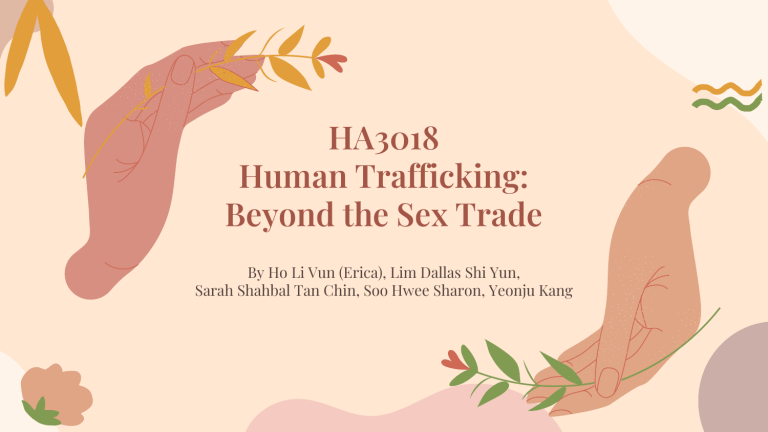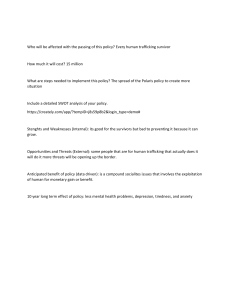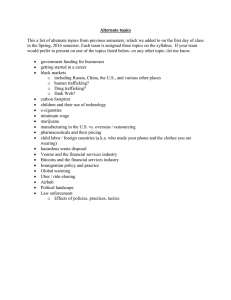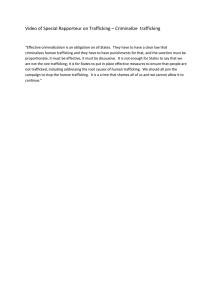
HA3018 Human Trafficking: Beyond the Sex Trade By Ho Li Vun (Erica), Lim Dallas Shi Yun, Sarah Shahbal Tan Chin, Soo Hwee Sharon, Yeonju Kang Overview 01 Reading #1 Summary 02 Reading #2 Summary Measuring the Nature and Prevalence of Human Trafficking (2020) Amy Farrell and Ieke de Vries The Slave Next Door, Chap 2: House Slaves Bales and Soodalter 03 Trafficking or Not? 04 Concluding Thoughts Case Study in Singapore Activity and Discussion A short recap & Other considerations 01 Reading #1 Summary Measuring the Nature and Prevalence of Human Trafficking (2020) Amy Farrell and Ieke de Vries ● Difficulties in measuring human trafficking victimisation due to: ○ ○ ○ ○ ● data constraints definitional limitations victims’ perspective detection problems Mainly, 4 methodologies have been outlined: ○ ○ ○ ○ Capture-Recapture Approach Multiple System Estimation (MSE) Local Surveys and Field Observations Online Domain Data and Network Information Importance of Data ● ● Data allows us to understand the magnitude of the problem ○ who is at risk of trafficking ○ the social conditions that breed trafficking crimes. Accurate data allows us to design more targeted and effective responses ● Challenge: data is fixated on the number of victims rather than the data of perpetrators and the nature of criminal organisations who traffick humans. Difficulties in Measuring Trafficking Victimisation Definitional Limitations ● Definitions are not universally agreed upon. ● The range of activities counted as human trafficking is contextual. ● Accurate measurements require precision in identifying the objects being counted. Victims do not recognise themselves as victims ● The public generally lacks information about human trafficking victimisation. ● A victim may not realised that they were exploited. Undetected Victims ● Perpetrators deliberately hide victims. ● Victims do not commonly seek help. ● ○ Victims may fear the repercussions of being reported to the police. ○ The police officials could be part of the human trafficking network. ○ Victims may be traumatised. Officials may not be able to recognise a human trafficking victim when they come across one ○ Lack of knowledge ○ Lack of procedures put in place such as screening tools and training Method 1: Capture-Recapture Approach via Open Source Info ● Estimate populations by taking independent samples of a population, and identifying likelihood of re-identification when the population is re-sampled ● By estimating the rough percentage that is never caught, derive the full number ● Used by social scientists to study hidden people/groups Method 1: Capture-Recapture Approach via Open Source Info Assumptions Made ● The population being studied is constant ● Subjects have equal chances of being captured each time ● The chances of being captured the second time must be independent of the first time Limitations ● Data quality ● Consistency ● Difficulty in obtaining identifying information of individuals in hidden populations Method 2: Multiple System Estimation via Admin. Records ● MSE is similar to the capture-recapture method, but uses administrative data from multiple sources instead of open sourced data to predict population sizes. Limitations ● Lack of data in many communities ● Officials may not accurately report information ● Confidentiality concerns Method 3: Local Surveys & Field Observations ● Captures information directly from people who may have been affected by human trafficking and populations that are harder to reach. ○ Chain referral sampling (snowball sampling) identifies ‘seeds’ who can refer and connect researchers to individuals who have experiences with human trafficking. ● It is also possible to integrate field survey questions into national public surveys. Method 3: Local Surveys & Field Observations Limitations ● Time and resource intensive ● Even if victims are disclosed, they may not be in a position to disclose their situations ○ ● they may be constricted by fear, shame and financial necessities Informants may selectively withhold information Method 4: Use of Online Domain & Network Approaches ● The internet allows traffickers to access a potentially new field of distanced victims, clients and other offenders. ● The internet offers a wider array of possibilities to detect crime. ● Machine learning, data mining, information retrieval and information integration to automatically compile and collect information from internet sources. ● Network analysis allows us to expose the structure and interactions within the human trafficking networks, the flow of goods, money and information. Moving Forward ● The importance of committing and be committed to improve administration data ● Funding is needed to support labour and time intensive studies ● New sources of data needs to be continually explored ● Collaboration is key 02 Reading #2 Summary The Slave Next Door, Chap 2: House Slaves Bales and Soodalter Key Points Desire & Ability to Escape Understanding the Trafficker Failure of Policy & Legislation Stakeholders in the Ecosystem Desire & Ability to Escape While at home ● Manipulation ○ The house as the only safe space (p. 22) → discourages her from leaving ○ Internalised immorality - ‘her enslavement is her own fault’ (p. 23) ○ Aided by her food & rest intake - keeps her confused & obedient (p. 24) ● Emotional attachment to the employer’s children ○ She doesn’t want to leave them unprotected with her employer (p. 24) Desire & Ability to Escape Escaping the home ● Fear of repercussion ○ Threats to loved ones, murder → ‘many victims, even when given the chance, do not testify’ (p. 21) ● Language and geographical isolation ○ Struggles to seek help ○ Loses her identity & ability to speak for herself (p. 23) Understanding the Trafficker Hunger for power perpetuates the domestic slave trade ● As opposed to profit (which is the main cause of other forms of HT) ○ ‘The families that hold and abuse domestic slaves can afford to pay for the same services in the normal way. For this kind of slavery, at least, the allure is power itself’ (p. 30) ● He desires absolute power because it is addictive and/or because he feels powerless in all other areas ● Exercising superiority ○ Attempts to use stress from personal life, racial & ethnic differences, and moral leadership to justify this action Failure of Policy & Legislation ● Employers often enjoy stronger legal protection ● Her visa is tied to her employer without further assessment ○ ‘To get the visa, the employer just has to state that he will provide ‘reasonable living and working conditions’ (p. 35) ● Lack of standardised, inclusive definitions of household workers leaves these women unprotected ○ ‘The National Labor Relations Act doesn’t include household workers in its definition of ‘employees’’ (pg. 22) ● Unfair charges against convicted slaveholders ○ ‘psychological coercion is extremely hard to prove’ (pg. 31) Stakeholders in the Ecosystem ● Au pairs ○ Have a network of friends; required to be paid at least the minimum wage; not allowed to work >45 hrs a week; must have a private bedroom; employers are assessed for suitability (pg. 36) ● Calls for ordinary citizens to be good samaritans 03 Singapore’s Domestic Worker Sector: Trafficking or Not? https://www.youtube.com/watch?v=Sj-vHlHEgtM&ab_channel=CNA Video Summary + Case Study ● The ban from Myanmar was put in place due to concerns over domestic worker abuse, especially in Singapore (and other parts of South Asia). ● Singapore continued to issue visas to domestic workers coming from Myanmar, and did not respond to Myanmar’s requests to sign a memorandum of understanding on the issue. ● Myanmar wants to protect their workers, but Singapore feels that workers with valid work permits are welcome to stay. This creates a grey area. ● Debt bondage Singapore’s Labour Laws Employment of Foreign Manpower Act (EFMA) Employment Act (EA) ● ● ● ● ● No more than 12 hour work days No more than 72 hours overtime per month General guidelines for overtime, rest day and public holiday pay Minimum standards on ○ notice periods, ○ annual leave and paid sick ○ and hospitalization leave. Excludes domestic workers as it is “quite different from normal work” ● No legal limits on working hours ● Ambitious language impacting MDW welfare ● ○ ‘acceptable’ accommodation, ○ ‘adequate’ food, ○ ‘adequate’ rest, ○ and ‘reasonable’ notice of repatriation Inconsistent enforcement Food for Thought! 1. 1. Is this considered human trafficking? Is the definition of human trafficking adequate in capturing the extent of this problem? List some reasons why Singapore would continue issuing permits to domestic workers arriving from Myanmar. Was it ethical for them to allow migrants from Myanmar without tightening laws in place to protect domestic workers? You may want to consider political, economic, socio-cultural and legal forces at play “Human Trafficking is the recruitment, transportation, transfer, harbouring or receipt of people through force, fraud or deception, with the aim of exploiting them for profit.” (UN Office of Drug and Crime) 1. In hindsight, was the ban on domestic worker migration justified in the attempt to protect its people or did it end up limiting opportunities for women instead? 04 Concluding Thoughts A Short Recap ● The importance of data accumulation and, what type of data is missing from the narrative & how data might be more accurately captured ● The layers of psychological, systemic, and institutional barriers of why trafficking is so difficult to escape from ● Potential issues with the definition of human trafficking Other Considerations ● Beyond the sector of domestic work, what other areas are trafficked persons forced (or led) to? ● What can we do?





